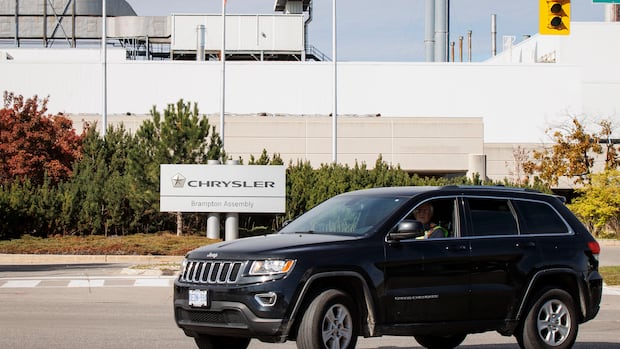General Motors has employed workers in Oshawa for generations. So while its presence in the city has been declining for decades, GM still looms large culturally, as hundreds of workers are expected to be laid off in the plant in the new year.
GM began its Canadian operations in Oshawa back in 1918. The auto giant has said it’s working on a plan to keep building in Oshawa for another 100 years.
But in the face of U.S. auto tariffs, what’s the future of the plant? Here’s what we’ve been hearing during our reporting on the looming layoffs.
GM will still build trucks
As first announced in 2023, GM is spending $280 million to build the next generation of Chevrolet Silverados in Oshawa.
“The associated plant upgrades are currently underway,” spokesperson Ariane Pereira said in an email.
Oshawa native Todd Forbes is one of some 2,000 workers who are set to be laid off in January when General Motors cuts the third shift at its Oshawa, Ont., plant. Some are considering moving elsewhere, amid high unemployment rates in the city and an auto industry under threat from U.S. tariffs.
The plant currently makes heavy and light-duty Chevy Silverados on the same line — the only GM plant to do so, according to the company’s website.
You might think it seems contradictory that GM is committing to building new trucks in Oshawa despite cutting a shift next year. But the additional product mandate is a “really good sign” for the plant’s future, says Dimitry Anastakis, the L.R. Wilson and R.J. Currie Chair in Canadian business history at the University of Toronto.
“That’s going to be a huge boost in confidence,” he said.
“Even if it does go down to two shifts, you’ve got a guarantee for the foreseeable future of significant production, which means significant employment,” Anastakis said.
Chris Waugh, Unifor chairperson for the Oshawa plant, said he wouldn’t comment on the impact of this production on workers.
Employment peaked in 1980s
CBC News has heard from some readers who say GM jobs are not important for Oshawa anymore. They’ve argued the city’s auto industry has been in decline for decades, and the city has moved onto other industries, including health care and technology.
It’s true the plant has dwindled in size over the past several decades, going from a peak of 23,000 employees in the 1980s to some 3,000 employees now.
Today, manufacturing industries only employ about three per cent of Oshawa’s workforce, city data shows.
But the GM plant is still a major employer of well-paying jobs with benefits, says Jeff Gray, president of Unifor Local 222, which represents the workers.
Here’s the autoworkers’ case
Oshawa autoworkers also appear to be good at their jobs. The plant has won 9 J.D. Power Initial Quality Study awards, which study new vehicle quality. That’s more than any other GM plant — though Oshawa won its most recent award in 2013.
It’s also worth noting that pick up trucks — or as Anastakis puts it, “big gas guzzling vehicles” — continue to be in high demand in North America.

The Oshawa plant has a highly skilled workforce that makes GM a highly profitable truck, Gray says.
“We make [GM] a lot of money,” he says. “We’ve been doing that for several decades.”
“Our business case is great,” Gray says, and it’s not just him trying to make this case. He says Lana Payne, Unifor’s national president, is pressing the federal government to come to a trade agreement with the U.S. that would put Canadian auto workers back on a “level playing field.”
CBC News has also heard that representatives from all levels of government are in regular talks with GM.
Building military vehicles is on the table
One possibility for the Oshawa plant is it could begin building military vehicles — and there is some precedent for this.
In July 2024, the Canadian military awarded GM Defense Canada a $35.8-million contract to build 90 light tactical vehicles — although they were built in North Carolina, according to media reports.
GM says it cannot comment on future product planning in Oshawa for competitive reasons. Oshawa Mayor Dan Carter also declined to provide details on his meetings with GM and the provincial and federal government.
General Motors has added 250 temporary jobs to its plant in Fort Wayne, Ind., as it prepares to cut hundreds of jobs in Oshawa in the new year. CBC’s Christian D’Avino visited Fort Wayne to learn more about where these jobs are going.
But the mayor did say he thinks there is an opportunity for the Oshawa plant to make military vehicles, which it did during the Second World War.
“We want to make a case that the workforce, the technology, the lines, the history is here, and we can meet whatever demands that they’re looking for,” Carter told CBC News.
Still, awarding a military contract would be less of a solution and more of a “possible bone thrown” to the plant, says Greg Layson, digital and mobile editor at Automotive News Canada.
“You’re never going to make 60,000 military vehicles a year the way you make 60,000 pick-ups per year,” he says. “But it’s some work on some level at some factories in Ontario.”
Could Oshawa become a hub for EVs?
The auto industry as a whole is transitioning toward electric vehicles (EVs), Anastakis says. Ideally, he says it would be great if GM were to retool the Oshawa plant to build EVs.
But, he says U.S. President Donald Trump’s policies have hurt this transition towards EVs, putting North American companies behind Chinese and European automakers.
Chinese manufacturers are “far and away” the leaders in EVs, says Greig Mordue, an associate professor of engineering at McMaster University and former Toyota Canada executive.
The world is going electric, and Canada is at a hinge point, he says.
“We can continue to coddle the Big Three [Ford, General Motors and Stellantis] that make about one vehicle in Canada for every two or three they sell, or we can embrace the new manufactures and take a more global outlook,” Mordue says.
Canada placed a 100 per cent tariff on Chinese electric vehicles last year. The federal government has faced calls to lift these tariffs and is looking at the possibility of doing so, despite concerns from Ontario Premier Doug Ford.
But Chinese EVs are more affordable than other EVs because most are made by state-backed automakers “with cheap labour under questionable labour practices,” Layson says.
Most of the factories are powered by coal fired power plants that generate electricity, he says.
Letting in Chinese-made EVs would also undercut the North American auto industry, as these automakers are trying to build out their own EV infrastructure and produce affordable EVs, Layson said.
“You have to ask yourself if you are willing to cut the tariffs on Chinese-made EVs, at what cost?” he said.
“It’s not just monetary. It’s moral, it’s ethical and it’s environmental.”







